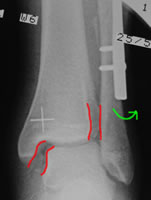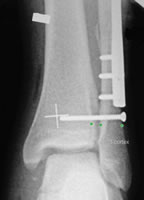





Ankle fractures with a syndesmosis injury and interosseous membrane rupture (AO type C) are severe, potentially unstable injuries.
Recent biomechanical and clinical studies have clarified these injuries and suggest we should be selective in syndesmotic stabilisation. As with other ankle fractures, an intact deep deltoid ligament will protect against tibio-talar displacement even with severe syndesmotic tears – tears up to 15cm above the ankle have been studied in cadaver experiments. However, if the medial malleolus is fractured or the DTTL torn, a low syndesmotic tear (existing data suggest <4.5cm from the ankle joint line) may still be stable if the fibula is anatomically reduced and fixed. Above this, a syndesmotic positioning screw is likely to be needed.
 |
 |
 |
If there is a medial malleolar fracture with the deep deltoid attached... |
If there is a fibular fracture within 4.5cm of the plafond... |
If the fibular fracture is >4.5cm above the plafond... |
 |
 |
 |
...stable fixation of this should stabilise the fracture, no matter how high the fibular fracture is. A plate would be applied to the fibula if feasible. |
...and the fibula can be fixed in stable configuration, the fracture would normally be stable |
...even stable fixation of the fibula will probably not stabilise the ankle |
In each case the construct should be stress-tested (see below) |
||
There are a number of issues in translating these biomechanical studies into real life:
Therefore, it is probably best to stress test all type C injuries after bony stabilisation. The syndesmosis should be stressed laterally, anteroposteriorly and in external rotation – Briggs et al (2004) suggested the main direction of instability is anteroposterior rather than laterally.
Biomechanical studies suggest a single 3.5mm cortex screw, through 3 cortices, about 2cm above the ankle joint line, is adequate for stability. Additional, or larger, screws, do not normally resuce the risk of late displacement. The screw should be inserted with the ankle dorsiflexed to prevent narrowing of the mortise. It should be a neutral, not a lag screw. Occasionally, however, a second screw is required in a highly-unstable fracture or a very large patient.
 |
 |
High fibular fracture with deltoid tear. Despite fixation of the fibula with a DCP, stress testing shows residual instability |
A 3-cortex 3.5mm positioning screw is inserted through three cortices 2cm above the plafond |
It is generally advised to keep patients with syndesmosis screws non-weightbearing until the screw is removed at 6-12 weeks, lest the screw should loosen or break, usually the former. Only two studies have recorded outcome in patients who had were allowed to weightbear without screw removal. Although several screws became symptomatic, no patient had a poor outcome related to the screw or to ankle stiffness. We do not routinely remove syndesmosis screws, nor do we restrict weightbearing or ankle movement solely because of their presence. Screws which become symptomatic are removed, generally under local anaesthetic.